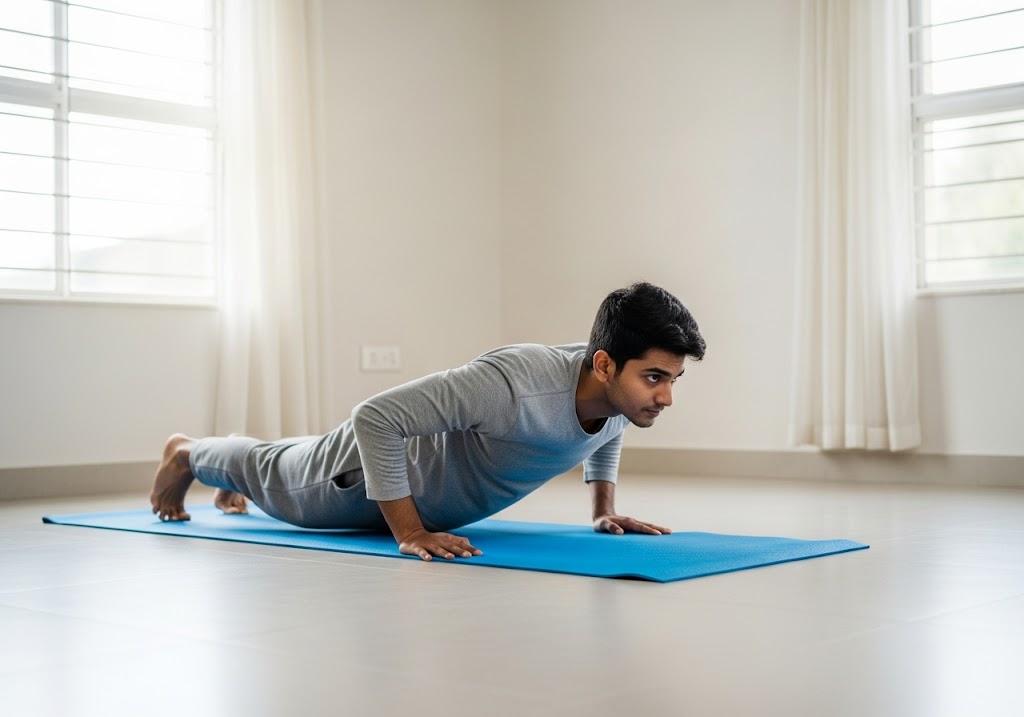How to do glute bridge involves lying on your back, bending your knees, and lifting your hips up while squeezing your glute muscles.
Learning how to do glute bridge is essential for building stronger glutes and improving your overall lower body strength. This simple yet effective exercise targets your glute muscles, hamstrings, and core without requiring any equipment. Whether you’re a beginner looking to activate dormant glutes or an experienced fitness enthusiast wanting to add variation to your routine, mastering how to do glute bridge will transform your posterior chain strength.
The glute bridge exercise has become increasingly popular among fitness professionals and everyday people alike. It addresses the modern problem of weak glutes caused by prolonged sitting and sedentary lifestyles. When you understand how to do glute bridge correctly, you unlock a powerful tool for improving posture, reducing lower back pain, and enhancing athletic performance. This exercise serves as both a warm-up movement and a strength-building exercise depending on how you incorporate it into your routine.
Table of Contents
How to Do Glute Bridge?
Understanding how to do glute bridge properly starts with mastering the basic technique and body positioning. This fundamental movement pattern forms the foundation for all glute bridge variations and ensures maximum effectiveness while minimizing injury risk. Proper execution activates your glutes optimally.
| Step | Action | Key Points |
|---|---|---|
| 1 | Lie on your back | Keep spine neutral, arms at sides |
| 2 | Bend knees 90 degrees | Feet flat, hip-width apart |
| 3 | Position feet properly | Heels 15-20 cm from glutes |
| 4 | Engage core muscles | Pull belly button toward spine |
| 5 | Squeeze glutes | Activate before lifting |
| 6 | Lift hips up | Create straight line from knees to shoulders |
| 7 | Hold at top | Squeeze glutes for 2-3 seconds |
| 8 | Lower slowly | Control the descent |
The key to learning how to do glute bridge effectively lies in the setup and execution. Start by lying on your back with your knees bent and feet flat on the ground. Your feet should be positioned hip-width apart, with your heels approximately 15-20 centimeters away from your glutes. This positioning ensures optimal glute activation throughout the movement.
When you lift your hips, focus on squeezing your glute muscles rather than just pushing your hips up. Drive through your heels and imagine you’re trying to squeeze a coin between your glute cheeks. Your body should form a straight line from your knees to your shoulders at the top position. Hold this position for 2-3 seconds before slowly lowering back to the starting position.
Step-by-Step Guide:
- Step 1: Lie comfortably on your back on a firm, flat surface
- Step 2: Draw your knees up with feet planted firmly on the ground
- Step 3: Position feet approximately shoulder-width apart with toes pointing forward
- Step 4: Rest your arms by your sides with palms pressing into the floor
- Step 5: Establish a neutral spine without excessive arching or flattening
- Step 6: Activate your core by gently drawing your navel toward your spine
- Step 7: Mentally focus on your glute muscles before beginning the lift
- Step 8: Drive forcefully through your heels to elevate your pelvis
- Step 9: Lift until your torso forms one straight line with your thighs
- Step 10: Avoid hyperextending your back or lifting too high
- Step 11: Contract your glutes as hard as possible at the peak position
- Step 12: Maintain alignment with knees tracking over your toes
- Step 13: Control the lowering phase with deliberate muscle tension
- Step 14: Touch down lightly before immediately beginning the next repetition
- Step 15: Complete all repetitions with consistent form and tempo
If you’re dealing with back discomfort, learn about which exercise is best for back pain relief and prevention strategies.
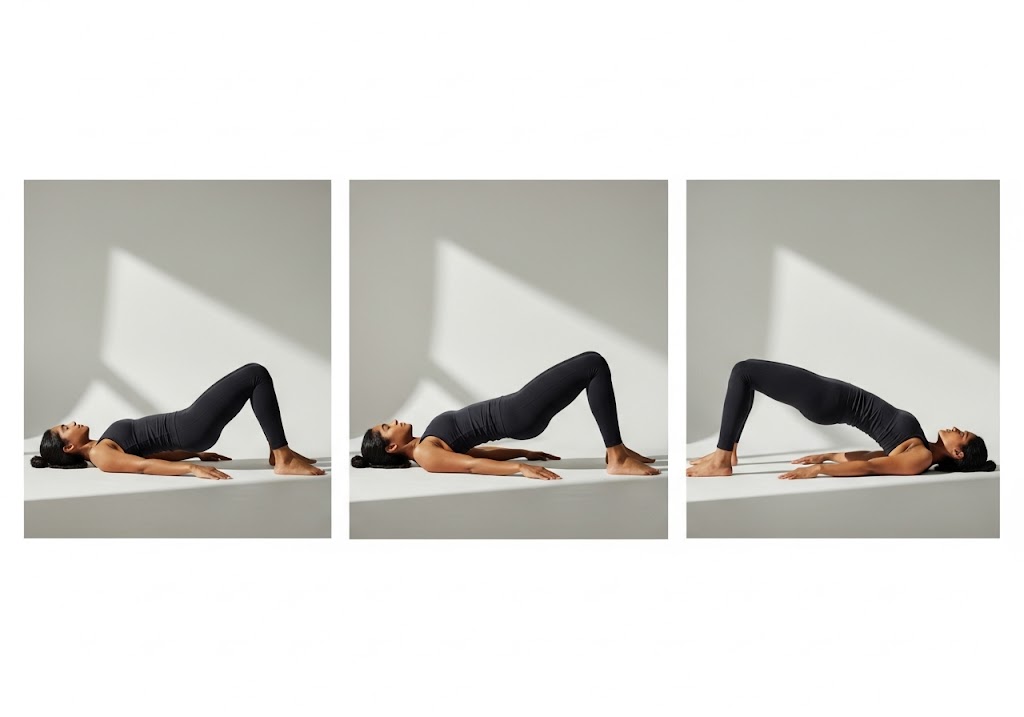
What is Glute Bridges?
Glute bridges are bodyweight exercises designed to strengthen and activate the glute muscles, particularly the gluteus maximus. This exercise involves lying on your back and lifting your hips off the ground while keeping your feet planted firmly. The movement primarily targets your posterior chain muscles including glutes, hamstrings, and lower back stabilizers.
The exercise gets its name from the bridge-like position your body creates when you lift your hips. Unlike other glute exercises that require standing or complex movements, glute bridges can be performed anywhere with minimal space. They serve multiple purposes in fitness routines, functioning as warm-up exercises, rehabilitation movements, or primary strength-building exercises depending on the intensity and resistance used. Understanding what glute bridges accomplish helps you appreciate their versatility and effectiveness in any fitness program.
Planning your return to regular exercise requires careful consideration – discover how to get back to exercise after a long break safely and effectively.
How to Strengthen Glutes?
Building stronger glutes requires a systematic approach combining various exercises and progressive overload principles. Glute bridges form an excellent foundation, but strengthening your glutes effectively involves multiple movement patterns and consistent training protocols for optimal muscle development and functional strength.
Here are the most effective ways to strengthen your glutes:
- Progressive Overload – Gradually increase resistance, repetitions, or hold time to continuously challenge your muscles
- Exercise Variety – Include different glute exercises like squats, lunges, deadlifts, and hip thrusts alongside glute bridges
- Consistent Training – Perform glute exercises 2-3 times per week allowing adequate recovery between sessions
- Proper Activation – Learn how to do glute bridge and other exercises with proper form to ensure glute recruitment
- Unilateral Training – Incorporate single-leg exercises to address imbalances and improve stability
- Resistance Bands – Add bands around your knees during glute bridges to increase glute medius activation
- Weighted Variations – Use dumbbells, barbells, or other weights to increase difficulty as you progress
- Time Under Tension – Slow down the movement and add pauses to increase muscle engagement
Check out our calisthenics at home no equipment routine for additional glute strengthening exercises.
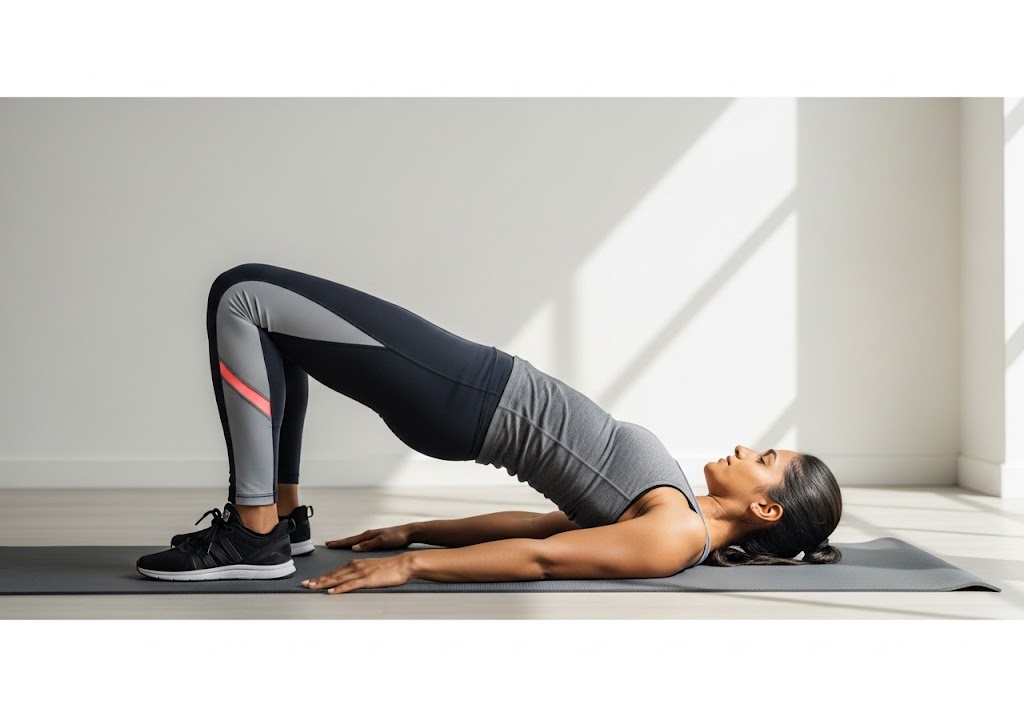
How to Do Glute Bridge Properly?
Executing the perfect glute bridge requires attention to detail and understanding of proper body mechanics. Many people think they know how to do glute bridge, but small form adjustments can dramatically improve effectiveness and prevent common compensations that reduce glute activation.
| Form Element | Proper Technique | Common Mistake |
|---|---|---|
| Foot Position | Hip-width apart, flat on ground | Too wide or narrow stance |
| Hip Height | Straight line from knees to shoulders | Lifting too high or not enough |
| Core Engagement | Belly button pulled to spine | Allowing back to arch |
| Glute Activation | Squeeze before and during lift | Relying on hamstrings instead |
| Breathing Pattern | Exhale on lift, inhale on lower | Holding breath throughout |
| Hold Time | 2-3 second pause at top | Rushing through the movement |
| Descent Speed | Slow and controlled | Dropping hips quickly |
Proper form begins before you even start moving. Position your arms flat against the ground with palms down to provide stability. Your feet should be planted firmly with weight distributed evenly across your entire foot, not just your heels or toes. This creates a stable base for powerful glute activation.
During the movement, focus on initiating the lift with your glute muscles rather than your lower back or hamstrings. If you feel the exercise primarily in your hamstrings, try moving your feet slightly closer to your glutes. If you experience lower back discomfort, ensure your core is engaged and you’re not overextending your spine at the top position.
Learn more about proper movement patterns with our warm up exercises for beginners routine.
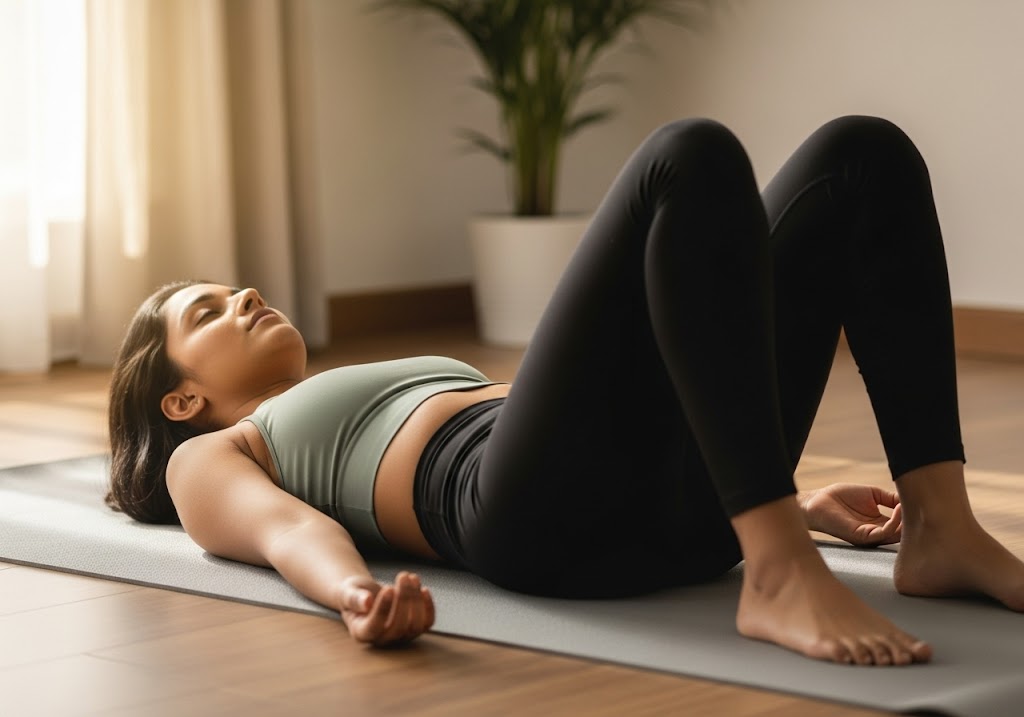
How Many Glute Bridges Should You Do?
The number of glute bridges you should perform depends on your fitness level, goals, and current training program. Beginners typically start with fewer repetitions and gradually increase volume as their strength and endurance improve. Advanced practitioners may perform higher volumes or add resistance to maintain challenge and continue progression.
For beginners learning how to do glute bridge, start with 2-3 sets of 10-15 repetitions. Focus on proper form rather than high numbers initially. As you become comfortable with the movement pattern and can perform it with perfect technique, gradually increase to 15-20 repetitions per set. The key is maintaining quality throughout every single repetition rather than rushing through high numbers with poor form.
For Beginners
Beginners should start conservatively when learning how to do glute bridge to build proper movement patterns. Begin with 2 sets of 8-12 repetitions, focusing entirely on form and glute activation rather than speed or high volume.
For Intermediate
Intermediate exercisers who have mastered basic glute bridge form can increase volume to 3-4 sets of 15-20 repetitions. Consider adding hold times or resistance bands to increase difficulty while maintaining proper technique throughout all sets.
For Advanced
Advanced practitioners should perform 3-4 sets of 20-25 repetitions or add external resistance. Single-leg variations and weighted versions provide additional challenges while keeping the fundamental movement pattern of how to do glute bridge intact.
Once you’ve mastered the glute bridge foundation, progress to upper body challenges like learning how to do arnold press for complete body development.
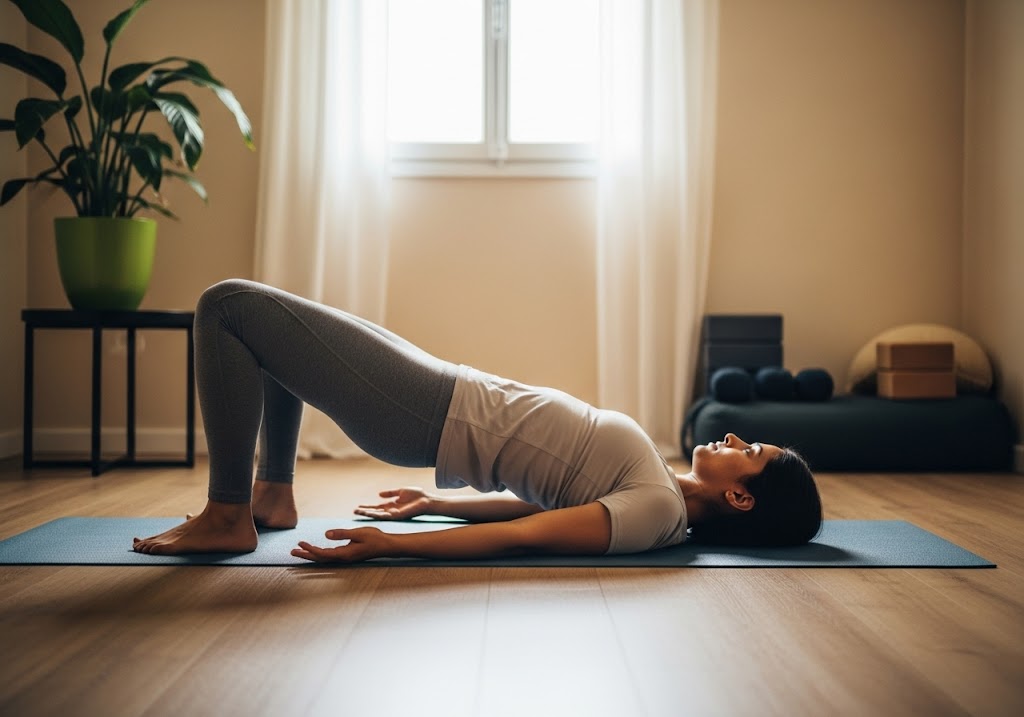
Are Glute Bridges and Hip Thrusts the Same?
While glute bridges and hip thrusts share similar movement patterns and target the same muscle groups, they are distinct exercises with key differences in setup, execution, and intensity. Understanding these differences helps you choose the right exercise for your current fitness level and training goals.
The primary difference lies in the setup position. Glute bridges are performed lying flat on the ground throughout the entire movement. Hip thrusts require your upper back to be elevated on a bench or similar surface, which allows for greater range of motion and typically accommodates heavier loads. Both exercises teach you how to do glute bridge movement patterns but with varying degrees of difficulty and equipment requirements.
Hip thrusts generally allow for heavier loading because of the elevated position and increased range of motion. The bench support provides stability for your upper body, allowing you to focus entirely on hip extension power. Glute bridges, while requiring less equipment, provide excellent muscle activation and are more suitable for beginners or those with limited equipment access. Both exercises complement each other well in a complete glute training program.
Explore our arnold press vs shoulder press comparison for more exercise variations.
How to Do a Lying Glute Bridge?
The lying glute bridge is a powerhouse exercise that activates your glutes, strengthens your posterior chain, and improves hip mobility in one simple movement. This fundamental exercise forms the cornerstone of functional fitness, helping to counteract the effects of prolonged sitting while building strength and stability. Perfect for beginners and advanced athletes alike, the lying glute bridge requires no equipment yet delivers remarkable results for muscle activation, core stability, and lower back health improvement.
Step-by-Step Execution:
- Step 1: Position yourself flat on your back with arms relaxed at your sides
- Step 2: Bend both knees and place feet flat on the floor
- Step 3: Keep your feet hip-width apart and parallel to each other
- Step 4: Ensure your heels are positioned about 6 inches from your glutes
- Step 5: Tighten your core muscles and maintain a neutral spine alignment
- Step 6: Focus on engaging your glute muscles before initiating movement
- Step 7: Press your heels into the ground and lift your hips upward
- Step 8: Create a straight diagonal line from your knees to your shoulders
- Step 9: Squeeze your glutes maximally at the top of the movement
- Step 10: Hold this peak contraction for 1-2 seconds
- Step 11: Slowly lower your hips back toward the floor with control
- Step 12: Stop just before your glutes touch the ground and repeat
When to Inhale and Exhale During Glute Bridge?
Mastering proper breathing mechanics during glute bridges significantly enhances exercise effectiveness, core stability, and overall performance quality. Strategic breathing patterns help maintain optimal intra-abdominal pressure, support spinal stability, and ensure adequate oxygen flow to working muscles throughout the movement. Understanding when to breathe in and out transforms this simple exercise into a more powerful tool for building strength, improving posture, and developing better movement control and body awareness.
Step-by-Step Breathing Pattern:
- Step 1: Begin lying down and take several normal breaths to relax
- Step 2: Take a deep inhale through your nose in the starting position
- Step 3: Hold your breath momentarily as you prepare to lift
- Step 4: Begin exhaling slowly through your mouth as you start lifting
- Step 5: Continue the exhale throughout the entire upward movement phase
- Step 6: Complete your exhale just as you reach the top position
- Step 7: Take a quick inhale if you’re holding the top position
- Step 8: Begin inhaling as you start lowering your hips down
- Step 9: Continue inhaling throughout the entire descent phase
- Step 10: Finish the inhale as you return to the starting position
- Step 11: Maintain this pattern: exhale on the way up, inhale on the way down
- Step 12: Avoid holding your breath for more than a few seconds
- Step 13: Keep breathing steady and controlled, never rushed or panicked
- Step 14: Use your breath to help maintain core engagement throughout
Compare training methodologies and their impact on body composition by exploring calisthenics body vs gym body differences.
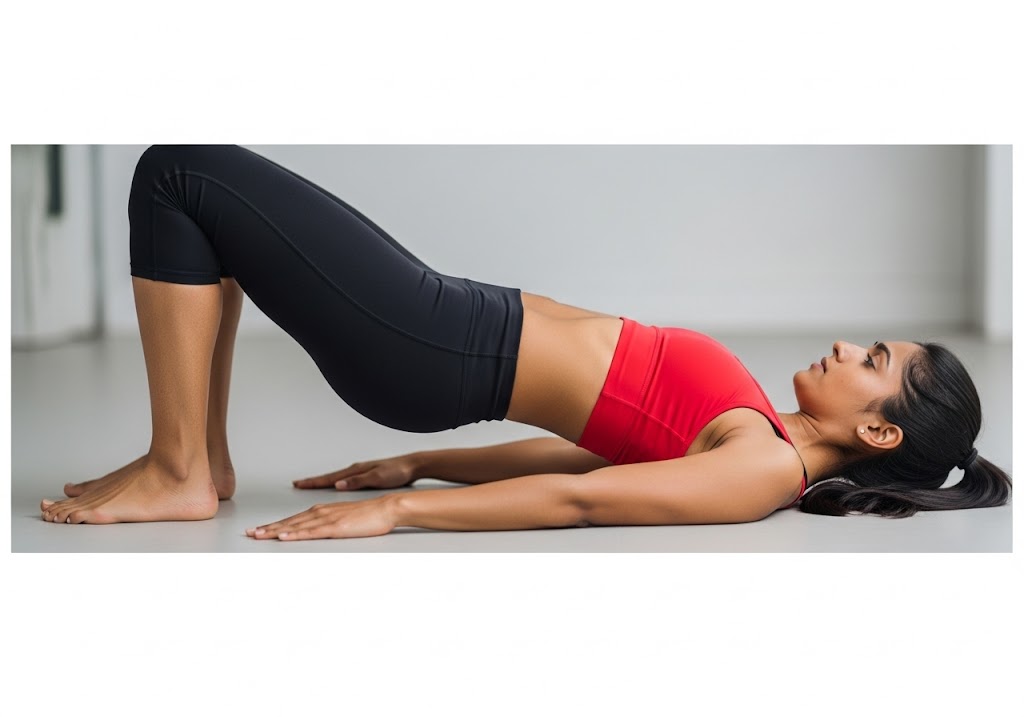
How Effective Are Glute Bridges?
Glute bridges rank among the most effective exercises for targeting the gluteus maximus and improving hip stability. Research consistently shows that this exercise produces high levels of glute muscle activation while being accessible to people of all fitness levels and requiring no equipment.
The effectiveness of glute bridges stems from several key factors:
- High Glute Activation – Studies show glute bridges activate the gluteus maximus more than many other common exercises
- Minimal Equipment Needed – Can be performed anywhere without gym access, making consistency easier to maintain
- Joint-Friendly Movement – Low impact exercise suitable for people with knee or back issues when performed correctly
- Progressive Overload Potential – Easy to make more challenging through variations, resistance, or increased volume
- Functional Movement Pattern – Mimics hip extension patterns used in daily activities like standing up and walking upstairs
- Core Stability Benefits – Requires core engagement to maintain proper positioning throughout the movement
- Injury Prevention – Strengthens glutes which support proper posture and reduce lower back pain risk
- Versatile Exercise – Functions as warm-up, rehabilitation tool, or primary strength exercise depending on application
Glute Bridge Variations
Mastering different glute bridge variations keeps your workouts interesting while targeting your glutes from various angles. These progressions allow you to continue challenging your muscles as you get stronger and prevent adaptation plateaus that can slow progress.
| Variation | Difficulty Level | Equipment Needed | Primary Benefit |
|---|---|---|---|
| Basic Glute Bridge | Beginner | None | Learn proper form |
| Single Leg Glute Bridge | Intermediate | None | Unilateral strength |
| Banded Glute Bridge | Intermediate | Resistance band | Glute medius activation |
| Weighted Glute Bridge | Intermediate-Advanced | Dumbbells/barbell | Increased resistance |
| Elevated Glute Bridge | Advanced | Bench/step | Greater range of motion |
| Pulse Glute Bridge | Intermediate | None | Time under tension |
| Marching Glute Bridge | Advanced | None | Core stability challenge |
Single Leg Glute Bridge
Single leg glute bridges challenge your balance and stability while working each glute independently. This variation helps identify and correct strength imbalances between your left and right sides, making it excellent for injury prevention.
Perform this variation by extending one leg straight up toward the ceiling while keeping the other foot planted. The working leg must handle your full body weight, making this significantly more challenging than the standard bilateral version.
Master this powerful shoulder move: how to do arnold press with step-by-step guidance
Weighted Glute Bridge
Adding external resistance transforms the glute bridge from a bodyweight exercise into a serious strength builder. Start with a dumbbell weighing 5-10 kg placed on your hip crease and gradually increase as you get stronger.
Hold the weight securely throughout the movement and consider using a towel or pad for comfort. Weighted versions require the same perfect form as bodyweight bridges but provide greater muscle building potential for advanced practitioners.
Learn about how to burn 500 calories a day to complement your strength training.

Common Mistakes to Avoid
Even though learning how to do glute bridge appears straightforward, several common mistakes can reduce effectiveness and potentially cause discomfort. Recognizing and correcting these errors ensures you get maximum benefit from every repetition while maintaining joint health.
Avoiding these mistakes will improve your glute bridge technique significantly:
- Arching Your Back Excessively – Keep your core engaged and avoid pushing your hips too high, which strains your lower back
- Using Your Hamstrings Instead of Glutes – Focus on squeezing your glutes first; if hamstrings dominate, adjust foot position closer to your body
- Placing Feet Too Close or Far – Experiment with foot placement to find the position that maximizes glute activation for your body
- Rushing the Movement – Perform each repetition slowly with control, especially the lowering phase for maximum muscle engagement
- Not Squeezing at the Top – Hold the top position for 2-3 seconds while actively contracting your glutes for optimal activation
- Allowing Knees to Cave In – Keep your knees aligned over your toes throughout the entire movement to protect knee joints
- Forgetting to Breathe – Maintain steady breathing pattern, exhaling during the lift phase and inhaling while lowering
- Ignoring Core Engagement – Keep your abs tight throughout to support your spine and improve exercise effectiveness
Combine training with nutrition: intermittent fasting plan that supports fat loss and muscle retention.
Benefits of Glute Bridges
Understanding the comprehensive benefits of glute bridges motivates consistent practice and proper execution. This exercise delivers multiple advantages that extend far beyond simple muscle strengthening, improving your overall quality of life and physical performance in various activities.
Regular glute bridge practice provides these significant benefits:
- Stronger Glute Muscles – Directly targets and strengthens all three glute muscles for improved power and stability
- Reduced Lower Back Pain – Strong glutes support proper pelvic alignment and take pressure off your lower back muscles
- Improved Posture – Counteracts the effects of prolonged sitting by strengthening posterior chain muscles that support upright posture
- Enhanced Athletic Performance – Stronger glutes contribute to better running, jumping, and lifting performance in sports and activities
- Better Hip Mobility – Regular practice improves hip extension range of motion that often becomes limited from sitting
- Core Stability Improvement – Requires core engagement throughout the movement, strengthening deep stabilizing muscles
- Injury Prevention – Balanced glute strength reduces risk of knee, hip, and back injuries during daily activities
- No Equipment Required – Can be performed anywhere, making it easy to maintain consistency in your fitness routine
- Joint-Friendly Exercise – Low impact movement suitable for people with joint issues or during injury recovery
- Functional Movement Pattern – Strengthens muscles used in everyday activities like standing, walking, and climbing stairs
Complement your glute training with our calisthenics ab workout for complete core strength.
Conclusion
Learning how to do glute bridge properly transforms your posterior chain strength and overall movement quality. This versatile exercise builds stronger glutes, improves core stability, and reduces lower back pain when performed consistently with proper form.
Want to master the calisthenics handstand and take your skills to the next level? Whether you’re a beginner or pushing advanced skills, ISC – Indian School of Calisthenics offers expert guidance to help you master bodyweight training. Visit us at SRPF Ground, NH8, Goregaon (E), Mumbai – 400065. For class schedules, personalized coaching, or more details, call +91 77159 53218. Train smart, move better, and unlock your back strength with ISC.
How to Do Glute Bridge? – FAQs
How to do glute bridge for beginners?
Start with 2 sets of 8-12 repetitions, focus on proper form, squeeze glutes at the top, and hold for 2-3 seconds.
How many glute bridges should I do daily?
Beginners should do 10-15 repetitions for 2-3 sets, while advanced practitioners can do 20-25 repetitions for 3-4 sets.
What muscles do glute bridges work?
Glute bridges primarily work the gluteus maximus, hamstrings, and core muscles while stabilizing the lower back and hips.
How to do glute bridge without feeling it in hamstrings?
Move your feet closer to your glutes, focus on squeezing glute muscles first, and drive through your heels rather than toes.
Are glute bridges effective for building muscle?
Yes, glute bridges effectively build glute muscle when performed with progressive overload, proper form, and adequate training frequency.
How to do glute bridge properly with weights?
Place a dumbbell on your hip crease, hold securely, maintain the same form as bodyweight version, and start with 5-10 kg.
Can I do glute bridges every day?
Yes, bodyweight glute bridges can be done daily as they’re low impact, but allow rest days if using heavy weights.
What’s the difference between glute bridges and hip thrusts?
Glute bridges are performed lying flat on the ground, while hip thrusts use an elevated surface for greater range of motion.
How to do single leg glute bridge correctly?
Extend one leg toward the ceiling, keep the other foot planted, lift hips using the grounded leg, and maintain balance throughout.
How long should I hold the glute bridge at the top?
Hold the top position for 2-3 seconds while actively squeezing your glute muscles for maximum activation and strength benefits.

